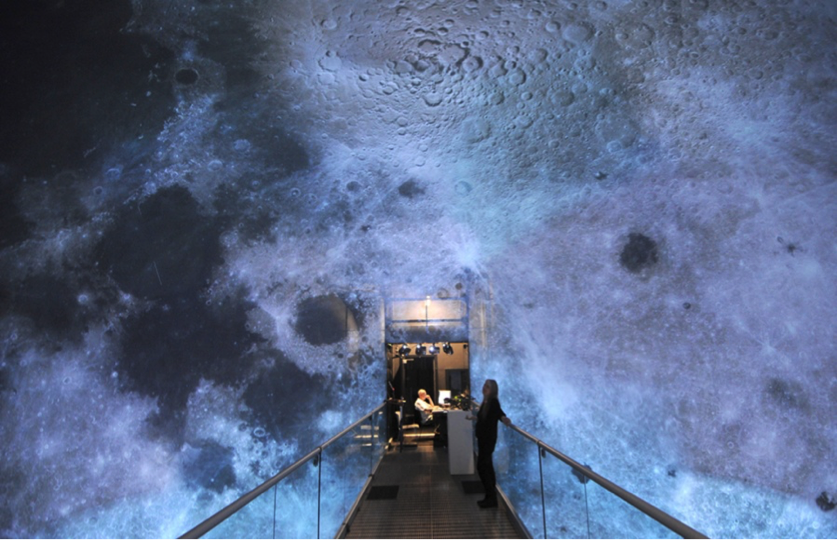By Sadie Wilbur
Allosphere Director JoAnn Kuchera-Morin, a professor of Media Arts and Technology and Music at UC Santa Barbara. Photo Courtesy of the University of California
Imagine if you could explore the world of atoms, fly through the human brain, and come face to face with the surface of the moon. After years of collaborative research, JoAnn Kuchera-Morin and her team of scientists, artists, and engineers have made this possible here at UC Santa Barbara.
The AlloSphere, a 3-story-high spherical research instrument completed in 2007, takes data too small to see or hear and visually and sonically magnifies it to the human scale, allowing scientists and engineers to interact with complex data like artists: creatively and intuitively. As researchers use the full capacity of their senses to explore new modes of expression and discovery, they forge a new frontier of research at the intersection of science, art, and engineering.
Leading the way is JoAnn Kuchera-Morin, a professor of Media Arts and Technology and Music at UC Santa Barbara. Kuchera-Morin began her creative life in higher education as an innovative composer, and she approached the design of the AlloSphere in much the same way that she composes a piece of music. In a recent interview, Kuchera-Morin, director of the research lab, discussed the importance of holistic thinking and a return to the learning-by-doing that the AlloSphere enables.
Q. What question or challenge were you setting out to address when you started your work here at UC Santa Barbara?
A. I've always been looking to answer one question that will never be answered, which is primarily, I think, what most artists do. That’s why there are artists; most of what they do deals with constantly searching for the meaning of life.
Quantum mechanics, understanding how and why the world works, has always fascinated me, but I didn’t have any kind of training in that area. So, it’s always exciting for me to be able to explore those areas of the unknown and I've had the opportunity to do that throughout my time here.
In day to day life, we intuitively understand how the world works and throughout my research, I’ve tried to extend this intuitive understand from the simple to the incredibly complex. To make the impossible, possible, or the unthinkable, thinkable. And as an artist, what has helped me do this is mathematics.
Q. Can you explain how mathematics has helped you in your research?
A. The one thing that most people don't understand is that music is all mathematics. Everything you do is mathematics. When I started working with what we call electroacoustic music composition, using the computer plus instruments, I started expanding that technology, expanding my mathematics.
When I wanted to push the boundaries with my compositions, I did that by extending mathematical principles, not only sonically, but also visually and interactively.
Q. It takes courage to explore a new frontier, and to push the boundaries of a genre — be it in art, science or engineering. What motivates you to get up in the morning and pursue your research, every day? What excites you about your work?
A. UC Santa Barbara is a highly interdisciplinary campus and it affords you the opportunities to explore in ways that you typically can't explore in other places, so that has been very exciting for me. In the 35 years that I've been here, absolutely nothing has ever been boring. As a matter fact, every day I come into the University, I hope I can teach the students that are in my midst because they're incredibly brilliant and hybrid in many ways. It’s a wonderful environment for me to be able to never be comfortable and always evolve and explore.
One example is the Media Arts and Technology (MAT) graduate program, which my colleagues and I launched in 2000. The program brings together four disciplines: Art, Computer Science, Electrical and Computer Engineering, and Music. In the program, it’s all about making and creating, and doing the research to build these complex systems. And then it’s about going from the high-level research to outreach, to engaging the community and educating the future.
Q. What is the importance of the AlloSphere and projects of this kind?
A. When you can interact with complex systems—visually, sonically, interactively—and play with it in your mind, you're going to comprehend it in ways like never before. You're going to understand how to apply it and it's going to take on a new level of importance for you since it is no longer something abstract.
We believe this is beginning a new era of teaching and reformation, which is learning by doing and understanding by seeing.
Sadie Wilbur is a fourth-year UC Santa Barbara student, graduating this spring with a major in Communication.
Lab director JoAnn Kuchera-Morin and media systems engineer Matthew Wright use an image of the moon to calibrate the AlloSphere research instrument.
Photo by Paul Wellman



